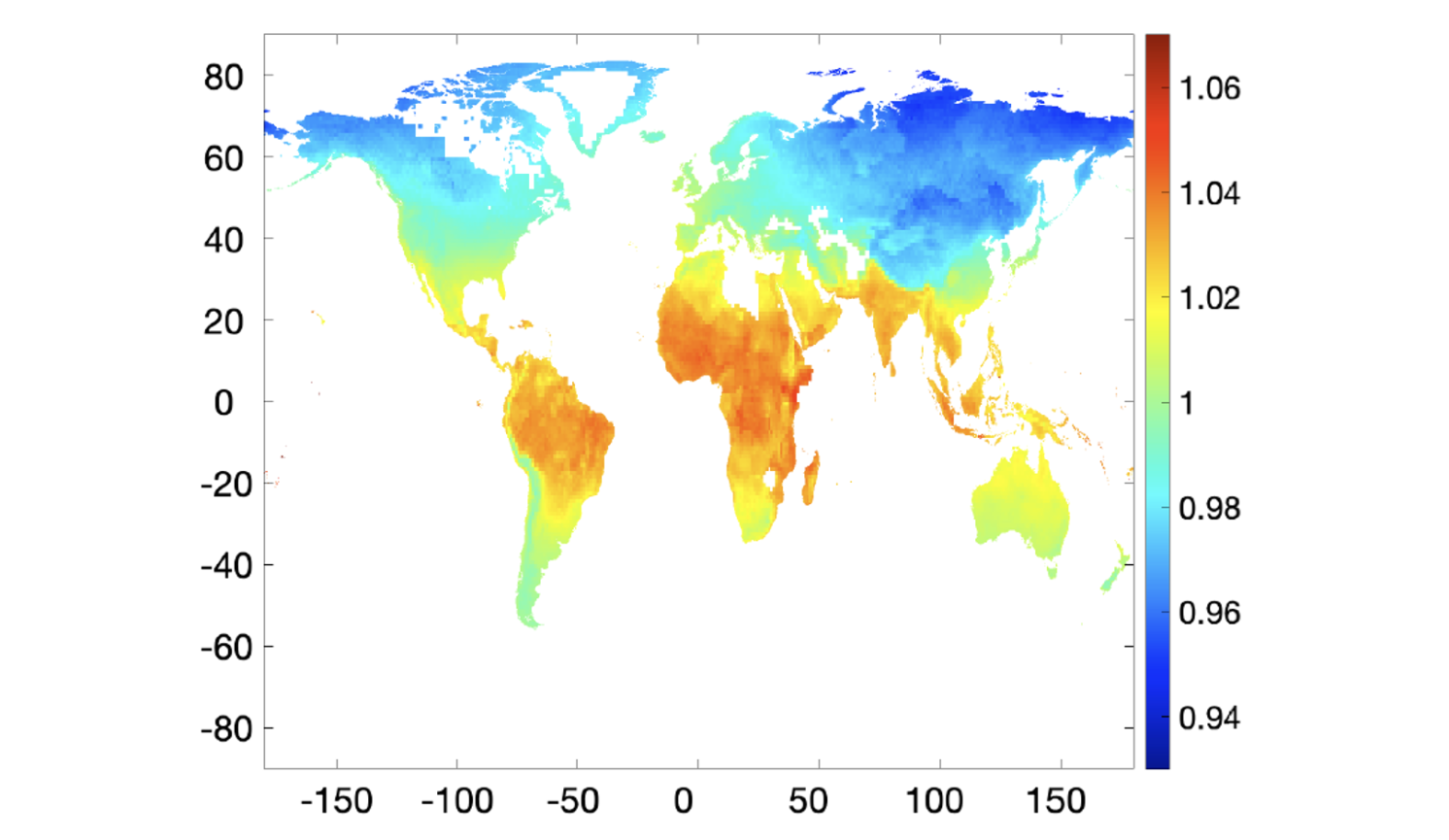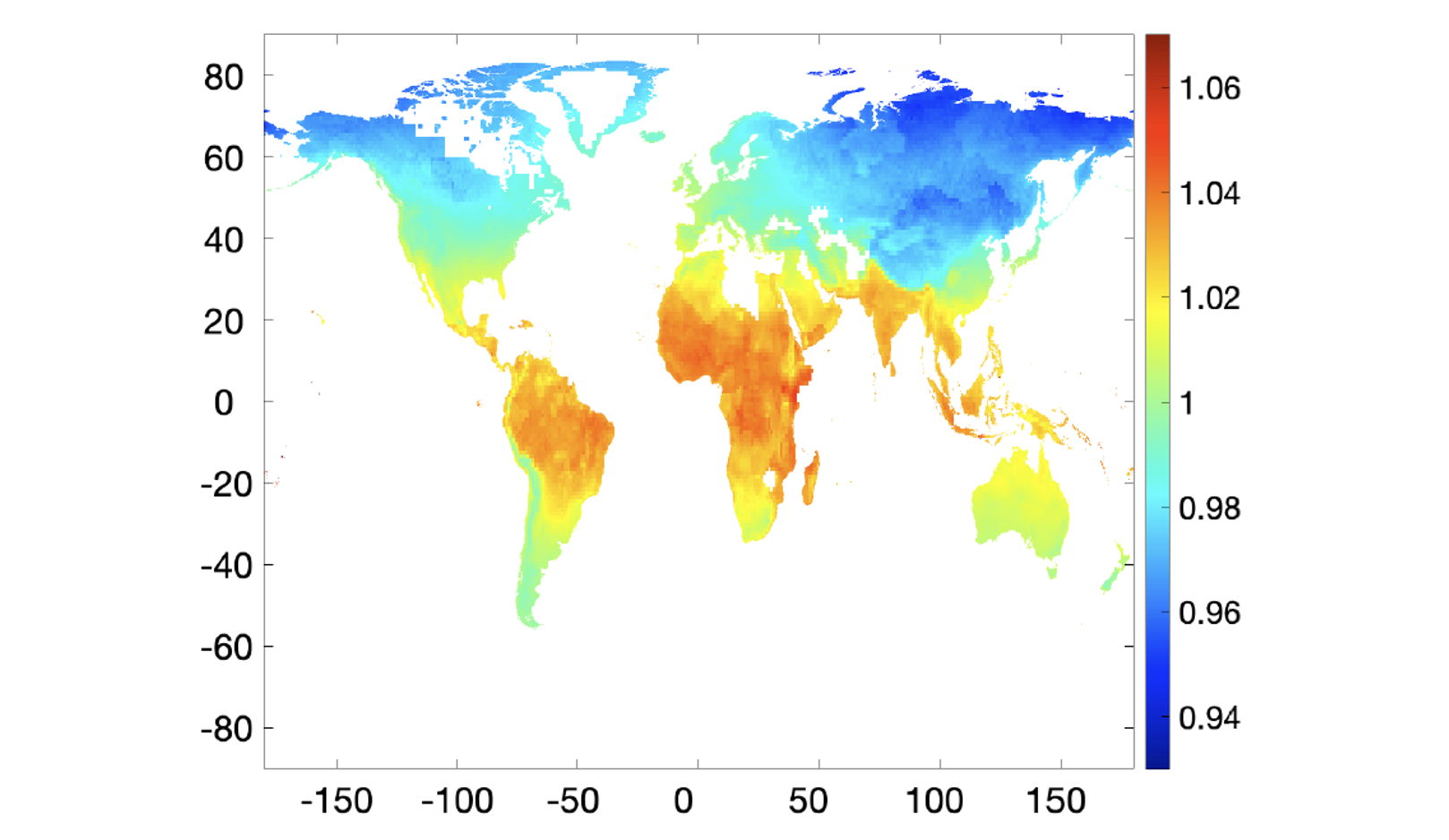Climate change is a spatial phenomenon. While it will be very costly at equatorial latitudes, where it is already very hot, it will have more benign effects at northern latitudes, where temperatures today are too cold to foster large concentrations of people and economic activity. This column discusses recent advances in the development of spatial integrated assessment to analyse the economic impact of global warming. The authors find that while important progress has been made in developing dynamic climate assessment models, much work remains to be done.
The average annual temperature range in the world is around 50C, which is much larger than the expected warming of the Earth due to anthropogenic climate change. Under the business-as-usual scenario, the Intergovernmental Panel on Climate Change (IPCC) projects that by the end of the century average temperatures will be between 1.4C to 4.5C above preindustrial levels. Since land in the colder northern latitudes is abundant and mostly unused for economic purposes, the immediate implication of these observations is that humanity could adapt to the economic consequences of climate change by shifting the location of economic activity.
Yet, changing the spatial distribution of economic activity is costly. In addition to political barriers, there are many other costs associated with migrating. We could also adapt by shifting production to sectors that are less hard hit by global warming. However, changing local specialisation is only possible if there is trade, which allows people to produce a different basket of goods from the one they consume. Of course, trade is costly too (Conte et al. 2021). Apart from migration and trade costs, there are other frictions to moving economic activity across space. If coastal cities become permanently inundated because of rising oceans, or particular areas get hit by storms, the physical infrastructure and the local knowledge embedded in these economic clusters are lost, and it takes time and additional investments for new clusters to emerge elsewhere. The bottom line is that the variety of spatial frictions to move goods, people, capital, technology, and any other factors of production should be central to evaluating the economic impact of global warming.
The need for spatial integrated assessment models
There is solid evidence documenting both the spatial heterogeneity in the impact of climate change and the role of moving as an adaptation mechanism to rising temperatures (e.g. Docquier et al. 2019, Kahn 2021, Di Falco et al. 2022). Yet, while a vast number of reduced-form empirical studies have identified many key facts about the economic impact of global warming across space, we need structural models to evaluate the economic cost of climate change across regions and over time, decompose the most relevant economic channels, and think about policy solutions. Statistically extrapolating into new economic configurations that we have not yet observed is problematic, especially given the long time horizons associated with climate change. To make appropriate predictions, we need models that combine everything we know about the workings of the world economy and its relation to climate.
Ideally, these climate assessment models should be global, have high spatial resolution, and be dynamic. A global approach is needed, because any local emissions mix rapidly in the atmosphere to generate changes in global temperatures, which in turn affect local temperatures. That is, carbon emissions are a global externality. The models should also have a high spatial resolution to accommodate both the large spatial heterogeneity in damages and the possibility of adaptation by moving economic activity across regions (sometimes over short distances, like with storms and coastal flooding). Finally, the models should be dynamic, since most of the impact of today’s emissions will be experienced in the future. In the last 30 years, William Nordhaus and others have pioneered the use of integrated assessment models (IAMs) that combine aggregate economic models with the main insights of climate science to evaluate the economic impact of global warming. While some of these models focus on more than one region, they lack the necessary geographic resolution to quantify the role of spatial frictions in migration, investments, trade, and innovation.
As reviewed in Desmet and Rossi-Hansberg (2024), the last decade has seen significant progress in developing dynamic spatial integrated assessment models (S-IAMs). The construction of these models has been aided by the burgeoning literature on quantitative spatial economics (Redding and Rossi-Hansberg 2017). This research has progressively produced more realistic and detailed models that incorporate empirically well-grounded spatial relationships. These high-resolution frameworks can be used to measure the impact of climate change on local productivity, amenities, and natality rates. By introducing trade and migration as potential adaptation mechanisms, these models lead to more realistic assessments of the cost of different phenomena, such as coastal flooding. Although these frameworks are dynamic, often the forward-looking decisions of agents are simplified to a sequence of static decisions to keep the models computationally tractable. However, a new generation of models is now capable of introducing forward-looking agents that make both migration and capital accumulation decisions. This allows studying the role of climate change anticipation in shaping adaptation responses.
The importance of spatial heterogeneity
To illustrate the importance of spatial heterogeneity within these frameworks, we take the S-IAM of Cruz and Rossi-Hansberg (2024) and analyse how the economic impact of global warming would change if we were to ignore spatial variation in damages from rising temperatures. As shown in Figure 1, averaging damages across the world would lead us to underestimate real income in polar latitudes, whereas it would make us overestimate real income in equatorial latitudes. In other words, we would fail to fully capture losses in sub-Saharan Africa by more than 6% in some areas, and we would underestimate the climate-induced increase in spatial inequality across the world.
Figure 1 Present discounted value of real GDP when averaging damages, relative to baseline without averaging


A future agenda for analysing the spatial implications of global warming
While important progress has been made in developing dynamic S-IAMs, much work remains to be done. A few examples of key remaining issues include:
- Green innovation: There is extensive work in the macro literature on the green transition and on directed technical change towards clean energy, but so far S-IAMs have not focused on purposeful local green investments in electricity generation, storage, and transmission. Incorporating directed technical change into an S-IAM with trade and migration seems essential to understanding how the green transition will shape the world’s economic geography.
- Substitution between clean and dirty energy: The elasticity of substitution between both types of energy depends on the composition of the stock of capital. For example, electric vehicles can easily switch between electricity produced by either fossil fuels or renewables, whereas gasoline cars cannot. Policy can be used not just to affect the production of clean energy, but also the size of the capital stock associated with different energy sources. Endogenizing the elasticity of substitution between renewable sources and fossil fuels by modelling investments in green and brown capital would be an ambitious addition to S-IAMs.
- Uncertainty: There is considerable uncertainty about climate change and its impact. Incorporating this uncertainty, together with parametric uncertainty in policy analysis, is essential. In addition, in the context of climate change, decision makers are faced with ‘deep uncertainty’, which extends to uncertainty or disagreement about the model itself. Work is needed to incorporate different forms of uncertainty into S-IAMs and perhaps bring some of the insights of robust decision-making into policy analysis.
- Endogenous migration frictions and conflict: Political borders are bound to play a large role in the world’s response to climate change. Many of the models we discussed predict an increase in climate-induced migration. Migratory barriers are of course an endogenous policy variable, and they are likely to respond to changes in migration flows. Understanding this process and incorporating it into S-IAMs is important to gain an accurate understanding of the virtues of migration as an adaptation mechanism. Local climate damages could also lead to conflict between and across countries as individuals fight for access to resources and for the right to occupy land.
- Climate policy coalitions: There is a mismatch between the countries that contribute the most to carbon emissions and those that suffer the most from climate change (Weder di Mauro 2023). The developed world has created a problem that impacts countries in the developing world especially hard. This differential impact makes reaching a global agreement on curbing emissions more challenging. Partly correcting for this mismatch is the fact that richer countries have a lower marginal utility of income. As a result, the reduction in consumption may be larger in some of the developed world, even if the utility impact of climate change is smaller. Since countries will primarily act based on their individual incentives, understanding the spatial distribution of the willingness to pay for climate policy and its impact on forming policy coalitions is crucial. S-IAMs can help.
In sum, much has been done, but much work is still needed. We expect this literature to grow substantially in the next decade.
Source : Voxeu



































































